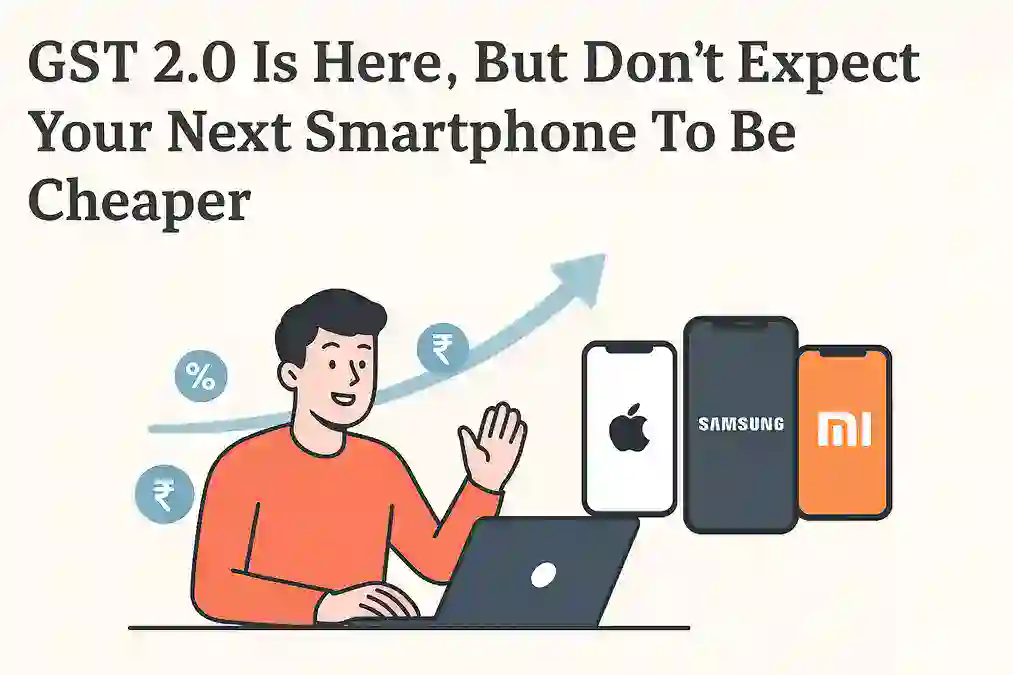India has officially rolled out what many are calling GST 2.0, a reworked version of the Goods and Services Tax that the government believes will make life easier for both consumers and businesses. The idea behind the reform is simple: reduce the number of tax slabs, lower the burden on several everyday products, and simplify a system that has often felt too complicated. For ordinary people, though, the big question has been whether this change will make high-value gadgets, especially premium smartphones, more affordable.
At first glance, it feels like good news. Televisions, refrigerators, washing machines, and even air conditioners are now attracting lower GST rates, which means households planning to upgrade their appliances will save a little money. But when you look at smartphones and laptops, the story changes. Despite all the excitement around GST 2.0, these products remain in the same 18 percent tax bracket as before. That means the dream of buying an iPhone, a Samsung Galaxy flagship, or a premium Xiaomi phone at a lower price is not yet a reality.
WHY GST 2.0
Why did the government draw the line here? The answer lies in revenue and perception. Smartphones are among the highest-selling electronic goods in India, and they bring in massive tax collections. Cutting GST on this category would have left a significant hole in government revenue. On top of that, there is still a perception in policymaking circles that while televisions and refrigerators have become middle-class necessities, premium smartphones are a discretionary luxury. If you can afford to spend more than fifty thousand rupees on a phone, the thinking goes, you can afford the tax too.
Another reason is balance. Any tax reform needs to make sense financially. If too many products are shifted into lower slabs, the government risks losing the fiscal stability it needs to run welfare programs and public projects. Smartphones and laptops were simply the easiest categories to leave untouched while still giving relief on other items.
So what does this mean for you if you were planning to buy a new phone? In plain terms, GST 2.0 won’t bring down the price of your next device. If you have been delaying your purchase in the hope of a tax cut, you might be disappointed. But this doesn’t mean that the price tag of a premium smartphone is frozen. Market forces, brand strategies, and seasonal sales still play a huge role in determining what you actually pay.
India is heading into its festive season, and this is the time when Amazon, Flipkart, and other retailers roll out their biggest offers. Even if the tax rate stays at 18 percent, there will be discounts, exchange deals, and bank offers that could reduce your cost by a meaningful amount. Add to that the fact that companies sometimes cut their own margins to stay competitive, and you may still get your phone for less, just not because of GST.
It is also worth remembering that import duties, supply chain costs, and currency fluctuations have just as much impact on prices as taxes do. If the rupee strengthens or global component prices fall, the benefits often get passed on to buyers. On the other hand, if costs rise, prices can go up regardless of what happens with GST.
The bigger debate, of course, is whether smartphones should really be treated as luxury goods anymore. In the last few years, the phone has stopped being just a gadget. It has become a digital payment tool, a classroom, an office, and even a government service portal. For many students and workers, a smartphone is the only way to access opportunities. The same can be said for laptops, which remain crucial for education and remote work. That raises an important question: should these products continue to be taxed at a higher rate while air conditioners and televisions get relief?
This is not just a consumer argument but a policy one. India is pushing hard on its Digital India initiative, encouraging everything from online banking to e-learning. If smartphones and laptops are key to that vision, then at some point the tax system will need to reflect their role as essentials rather than luxuries. For now, though, GST 2.0 stops short of making that leap.
Also Read:- Trump’s $100K H-1B Fee Hits Indians Who Hold 70% of Visas
If you are in the market for a high-end phone, the smartest strategy remains the same as it was before. Time your purchase during festive sales, look for exchange offers that give you decent value for your old device, and keep an eye on bank discounts or EMI schemes that can take the sting out of a large upfront payment. And if you are not hung up on having the latest model, buying last year’s flagship is often the best way to get premium features without paying a premium price.
GST 2.0 is an important reform and one that does make a difference for households planning to buy appliances. But for the tech-savvy crowd dreaming of cheaper iPhones or foldable Samsungs, it is largely a missed opportunity. The government has chosen to play safe, keeping a key source of tax revenue intact while offering relief elsewhere. The result is that your living room may benefit from the new system, but your pocket won’t feel lighter when it comes to premium gadgets.
In the end, GST 2.0 does succeed in simplifying the system and offering relief to many categories of goods, but it leaves smartphones and laptops untouched. That means high-end devices will remain as expensive as they were before, and buyers will have to depend on market discounts and brand offers rather than government policy to make their purchase more affordable. For now, the upgrade cycle for premium phones in India will continue to be shaped more by festive sales and competitive pricing than by tax reforms.

